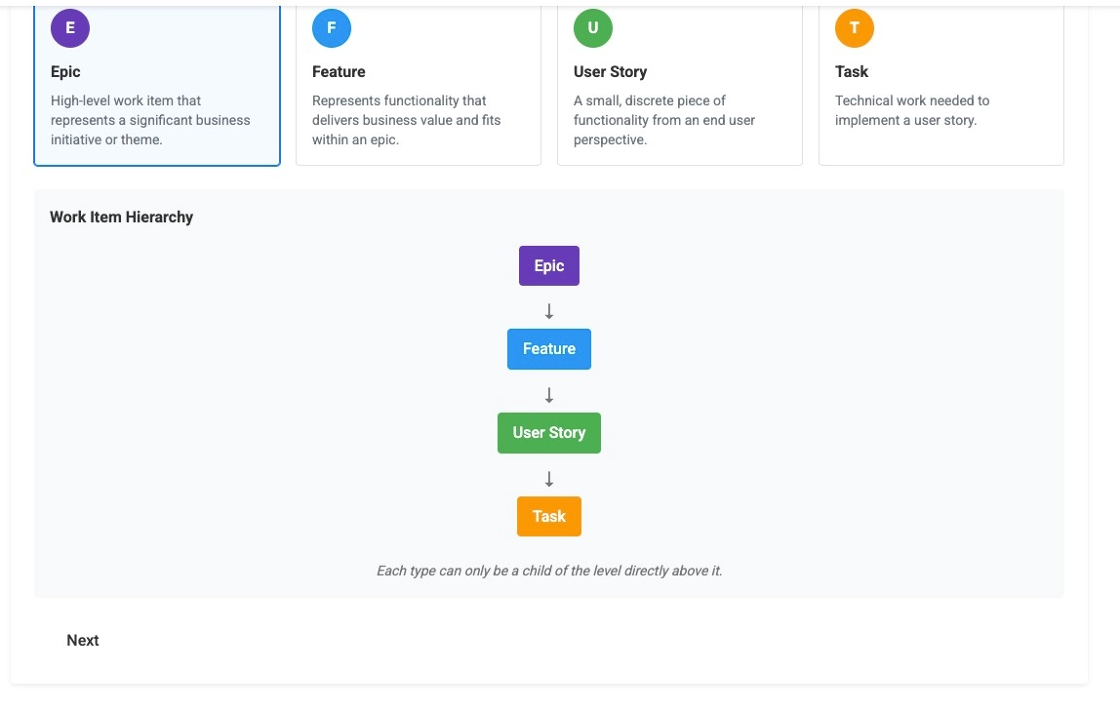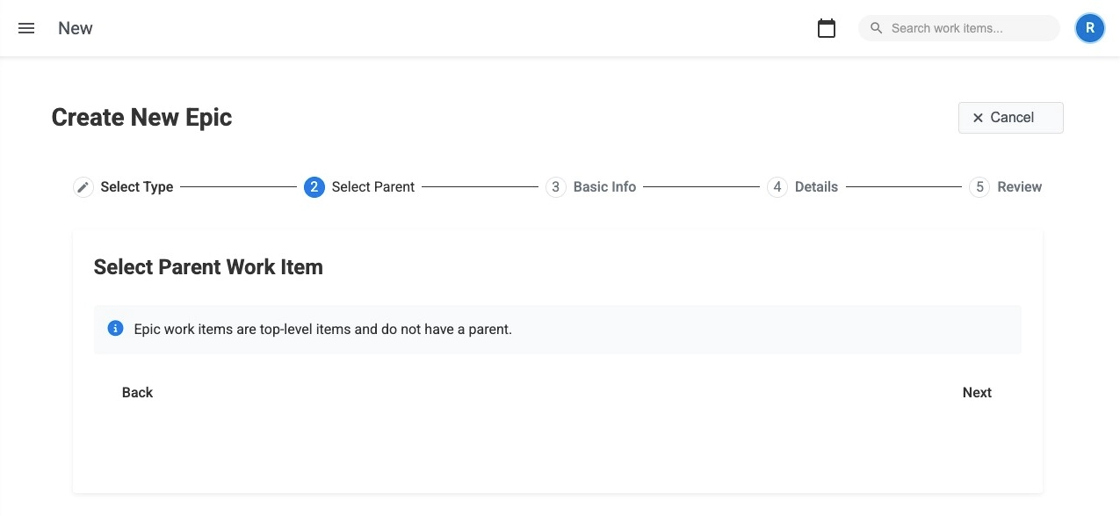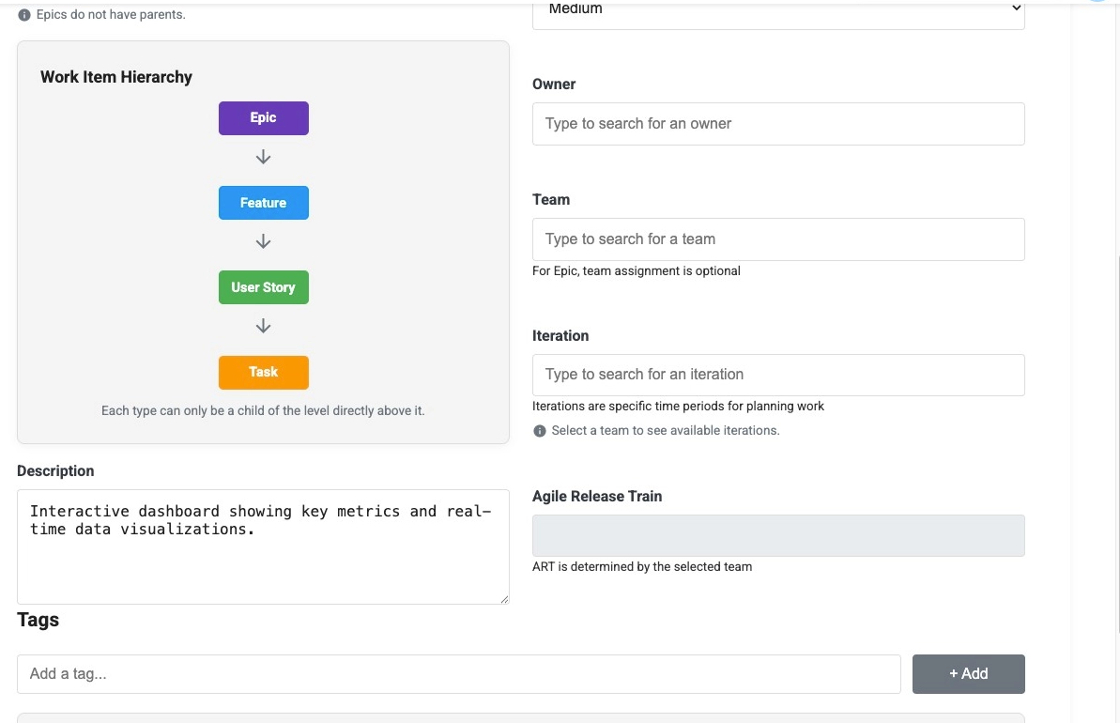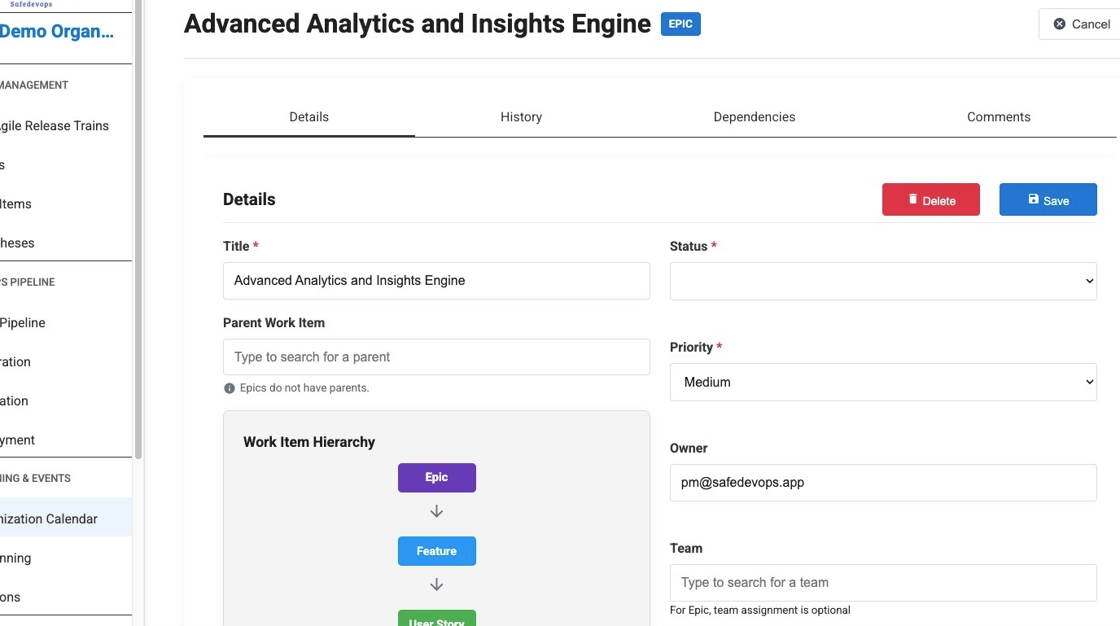Managing Epics
In the Scaled Agile Framework (SAFe®), an Epic is a container for a significant solution development initiative that captures the more substantial investments that occur within a portfolio. Safedevops.app provides tools to create, manage, and track your Epics from ideation through implementation.
What is an Epic? Epics are the largest units of work in the SAFe® portfolio and are used to capture and analyze major business initiatives. They are broken down into Features for implementation by Agile Release Trains (ARTs).
Epic Characteristics:
- Strategic Level: Epics represent significant business investments and strategic initiatives
- Portfolio Scope: They operate at the portfolio level, spanning multiple Program Increments
- Value-Driven: Each Epic should deliver measurable business value and outcomes
- Decomposable: Epics are broken down into Features, which are then implemented by ARTs
- Timeline: Typically require 3-12 months to complete, depending on scope and complexity
Permission Required: To create and manage Epics, users typically need a role with elevated permissions, such as Product Manager or Release Train Engineer (RTE).
→ See Default Role Permissions
Creating a New Epic
You can create a new Epic using the Work Item Wizard, which guides you through the necessary steps. The wizard ensures that you provide all the essential information while maintaining the proper hierarchy within the SAFe framework.
1. Start the Work Item Wizard
Navigate to the Work Items page from the main sidebar and click the "Create Work Item" button to launch the creation wizard. The wizard provides a guided experience for creating different types of work items, including Epics.
2. Select "Epic" as the Work Item Type
In the first step of the wizard, you'll see all available work item types. Select "Epic" from the dropdown list. Epics represent the largest units of work in your portfolio and serve as containers for significant solution development initiatives. Notice that Epic is positioned at the top of the hierarchy, indicating its strategic importance.

3. Skip Parent Selection (Epics Have No Parents)
Since Epics are the highest-level work items in the SAFe hierarchy, they do not have parent work items. The wizard automatically recognizes this and either skips the parent selection step or shows it as not applicable. This is a key characteristic that distinguishes Epics from Features and User Stories, which must have parent relationships.

4. Provide Basic Information
Enter a clear and concise Title for your Epic (this is required). The title should reflect the strategic nature of the Epic and be easily understood by all stakeholders. Provide a detailed Description that outlines:
- The Epic's scope and business objectives
- Expected benefits and value proposition
- High-level acceptance criteria
- Any relevant background or context
5. Configure Epic-Specific Details
Set the initial details for your Epic. Note that Epics have different field requirements compared to other work item types:
- Status: Set initial status (typically "Proposed" or "New")
- Priority: Assign business priority (Critical, High, Medium, Low)
- Owner: Optionally assign an Epic Owner (usually a Product Manager or Solution Manager)
- Team: Leave blank - Epics operate at the portfolio level and are not assigned to specific teams
- Iteration: Leave blank - Epics span multiple iterations and are not tied to specific sprints
- Agile Release Train: Usually left blank - Epics may span across multiple ARTs

Why are Team, Iteration, and ART fields left blank for Epics?
Epics operate at the portfolio level and represent strategic initiatives that:
- Span multiple Program Increments (PIs)
- May involve multiple Agile Release Trains
- Are broken down into Features for implementation
- Require portfolio-level governance and prioritization
6. Review and Create the Epic
Review all the information you've entered to ensure accuracy and completeness. Pay special attention to:
- Title clarity and strategic alignment
- Description completeness and business justification
- Appropriate priority level
- Correct owner assignment (if applicable)
Viewing and Managing Existing Epics
Once Epics are created, you can view and manage them through the Work Items interface. The system provides multiple views to help you track Epic progress and manage your portfolio effectively.
Accessing Epic Views
From various pages in the application, including the hypotheses management page, you can see existing Epics in your portfolio. Each Epic is displayed with key information including its title, status, and progress indicators. Click on any Epic to access its detailed management interface.

Epic Portfolio View
The portfolio view allows you to:
- Overview All Epics: See all Epics across your organization in a single view
- Status Tracking: Quickly identify Epic status and progress
- Priority Assessment: View Epic priorities and make portfolio decisions
- Resource Planning: Understand resource allocation across Epics
Editing an Epic
Once an Epic is created, you can edit its details, manage its relationships, and track its progress from its dedicated detail page.
1. Open the Epic Details Page
From the Work Items board or list view, find the Epic you wish to edit and click on it to open its full detail page.
[Screenshot of a work item board with an Epic card being clicked.]
2. Update Details and Manage Tabs
Use the tabs on the detail page to manage the Epic:
- Details: Modify core fields like Title, Description, Status, Priority, or Owner. You can also manage Tags here.
- Dependencies: Visualize and manage dependencies between this Epic and other work items.
- History: View a complete audit trail of all changes made to the Epic over time.
- Comments: Collaborate with stakeholders by leaving comments and attachments.
[Screenshot of the Epic's detail page, focusing on the tabs and editable fields.]
Epic Lifecycle and Status Management
Epics progress through a defined lifecycle that reflects their maturity and implementation status. Understanding this progression helps stakeholders track investment decisions and portfolio health.
Epic Status Progression
Epics typically move through the following statuses:
- Proposed: Initial Epic idea submitted for consideration
- Analyzing: Epic is being evaluated for feasibility, cost, and business value
- Portfolio Backlog: Epic approved and prioritized in the portfolio backlog
- Implementing: Features are being developed by one or more ARTs
- Done: All Features completed and Epic objectives achieved
- Cancelled: Epic removed from consideration due to changing priorities or constraints
Epic Ownership and Governance
Effective Epic management requires clear ownership and governance structures:
- Epic Owner: Typically a Product Manager or Solution Manager responsible for Epic success
- Portfolio Management: Lean Portfolio Management (LPM) function provides oversight and funding decisions
- Value Stream Stakeholders: Business stakeholders who benefit from Epic outcomes
- Solution Management: Technical leadership ensuring solution architecture alignment
Monitoring Epic Progress
Track Epic advancement through various metrics and indicators:
- Feature Completion: Percentage of child Features completed
- Business Value Delivery: Measured outcomes against Epic objectives
- Investment Tracking: Cost versus budget and ROI calculations
- Risk Assessment: Identification and mitigation of Epic-level risks
- Dependency Management: Cross-Epic and external dependencies
Best Practices for Epic Management
Epic Definition and Scoping
- Clear Business Outcomes: Define measurable business objectives and success criteria
- Appropriate Sizing: Ensure Epics are substantial enough to warrant portfolio attention but not too large to manage effectively
- Value Hypothesis: Include a clear statement of expected business value and how it will be measured
- Acceptance Criteria: Define high-level criteria that must be met for Epic completion
Collaboration and Communication
- Stakeholder Alignment: Ensure all key stakeholders understand and support the Epic
- Regular Reviews: Conduct periodic Epic reviews to assess progress and adjust course
- Transparent Reporting: Provide clear visibility into Epic status and progress
- Cross-Functional Input: Involve technical, business, and user experience perspectives
Portfolio Integration
- Strategic Alignment: Ensure Epics support overall business strategy and objectives
- Resource Planning: Consider Epic resource requirements in portfolio planning
- Dependency Mapping: Identify and manage dependencies between Epics
- Investment Prioritization: Use weighted shortest job first (WSJF) or similar methods for prioritization
What's Next?
After defining your Epics, the next step is to break them down into smaller, manageable pieces of work that can be delivered by your Agile Release Trains.
- Create Features under your Epic: Decompose the Epic into Features that deliver value.
→ Managing Features Guide - Learn about the Work Item Hierarchy: Understand how Epics, Features, and Stories relate to each other.
→ Work Items Management Guide